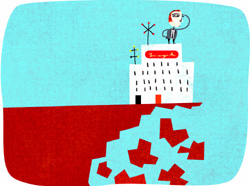Chastang directs many small business owners toward the “Open for Business” program, developed by the Institute for Business and Home Safety (IBHS), a nonprofit organization supported by insurance companies. The program, which is available in a Web-based format to member insurers’ customers and for download by any business from the group’s Web site, includes information about disaster preparedness and a series of worksheets to help business owners think through everything they would need to recover from a disaster, including how to contact key vendors and continue meeting payroll.
Chubb Insurance developed a similar tool for its clients. It breaks disaster preparedness planning into three components: before, during, and after the event. But Sam K. Lee, vice president of risk management services for Chubb Services Corp., says that he also encourages clients to begin the planning process by thinking of a generic scenario, such as a disaster that forces their office to be closed for a month. “What do you do?” he asks. “That helps them get started. If you develop a plan for a scenario, you don’t need a lot of contingencies. You’ll meet 80 percent of what can go wrong with your business.”
Cover Me Such types of planning exercises can help business owners become more informed insurance consumers, says Diana McClure, assistant vice president of business protection for the IBHS. “They begin to realize what insurance coverages they really need, or they understand the options better.”
Experts strongly encourage small businesses to look closely at what their insurance covers early in planning for disasters. Many builders assume that their builders’ risk and additional property insurance will get them through. While those may cover the costs of repairing physical damage, they likely won’t make up for lost income if there’s a period of time when the company can’t operate.
That’s where business interruption insurance comes in. It’s a type of “time element” insurance, meaning that it’s bought in terms of days, weeks, or months of coverage; the cost rises accordingly. Chastang says that many small business owners decline the coverage for that reason, but “it’s something a business should consider,” she says. Many respondents to the NFIB disaster survey might like a chance to reconsider: Among those who said they’d been affected by a disaster, 62 percent said their biggest problem was the loss of sales and customers; 59 percent weren’t adequately insured to cover the loss of those sales.
Getting Through But insurance is just one piece of a disaster preparedness plan. “It doesn’t help you with your reputation or how you handle a disaster,” McClure cautions. “Have you met your customers’ needs? What if a competitor gets up and running much faster?”
A clear communication plan lets both customers and employees know what the business’s plan is following a disaster. Rumors often develop in the absence of direct communication, says Chastang of the SBA. She recommends developing plans for communicating both with employees and outside stakeholders, such as customers and vendors, which can sometimes be accomplished through the media. “Make sure people know you’re rebuilding, you’re still going to fulfill orders, or any new phone numbers,” she says. “That will ensure confidence with [your] customer base and employees.”
McClure emphasizes “redundancy and alternatives.” Know multiple ways to reach your employees and keep that information wherever you might need it—in the office, at home, in your car. Think beyond the obvious, she says. In a disaster, cell phone lines might be flooded, but text messaging or satellite phones could work. “The idea is developing alternative ways of communicating and thinking of them ahead of time,” she stresses.
Plan to Back up—and Move Forward Most disaster plans appear in the area of technology. Many business owners say that they routinely back up their computer files, and that those backups are kept in an off-site location. But what if the disaster is region-wide? The SBA recommends keeping at least one set of vital records at least 50 miles away, which can help speed the recovery process after a disaster.
As small businesses’ disaster planning matures from keeping backup tapes in a bedroom drawer to keeping them in a storage facility in a nearby state, experts challenge managers to integrate disaster preparedness into their businesses’ strategic plans. “Good companies are always thinking of contingencies. Planning is not a separate part of the business,” OneBeacon’s Sidoti says. “When you’re deciding how many pieces of equipment to get, think about how it impacts your continuity planning or the long-term survival of the company.”
In other words, the more often you ask, “What if?” the more comfortable you’ll be with the answers. —Michele Mariani. A version of this story originally appeared in BUILDER magazine, a sister publication of PROSALES.

